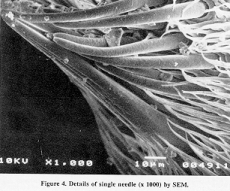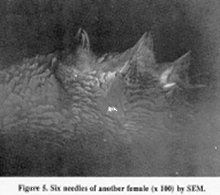Articles
Female Monarch Butterfly's Needles Designed for Survival
by Jules H. Poirier
There are many marvelous evidences of creative design in the structure and life history of the Monarch butterfly. Only one example—that of its remarkable forelegs—is considered in this article.
The female Monarch butterfly has six microscopic needles on each foreleg. The male Monarch butterfly forelegs have no needles, only hairs. Some evolutionary scientists say that since the small 0.2-inch forelegs have no useful purpose, they will eventually disappear. However, this belief is far from the truth. These needles are vital for the very survival of the Monarch butterflies.
The reason most evolutionary entomological scientists believe these small forelegs will disappear is because they have never studied their use in great detail or from the right perspective. They believe this complex, beautiful butterfly came into existence by random chance or accident many millions of years ago. They assume that since the other two pairs of legs are so much larger and more useful in grasping and tasting things, that these small forelegs must be shrinking and eventually will disappear. But remember that no human has ever seen random chance produce a complex, organized, living creature or structure. Even if humans were ever able to make a living cell in the laboratory, it would be by a complex and well-organized design and construction process, not by random chance, and the forelegs of the Monarch butterfly are extremely well-designed for their specific functions.
The Monarch butterfly has six legs. The two forelegs, located just under the head, are very small, requiring a magnifying glass or microscope to see them. Figure 1 shows a male and female foreleg side by side. The tips of each of the female forelegs carry three pairs of copper colored, microscopic needles. Figure 2 shows a female foreleg magnified by scanning electron microscope (SEM), obviously a well designed structure.
 
The female butterfly in search of a suitable place to lay her eggs, taps these six foreleg needles into the milkweed several times causing the milkweed fluids to flow onto the surface of the leaf. The female tastes and smells the fluids and determines whether the milkweed is suitable for laying her eggs. She determines this by use of taste sensors on the bottom of the other four legs and the smell sensors on the ends of each of the antennae. Normally she lays only one egg on the bottom of a single milkweed leaf, but she lays a total of about 600 eggs altogether. The milkweed must contain enough water and nutrients to supply the vital requirements for the growth and survival of the baby caterpillar once it emerges from its egg. Figure 2 shows a female foreleg magnified 100 times by a Scanning Electron Microscope (SEM); obviously a well-designed structure.
The male forelegs are shaped differently. The SEM photo in figure 3 shows the tip of a male foreleg magnified 100 times. Note that the male foreleg has no microscopic needles to make a chemical analysis of the milkweed because males do not lay eggs and have no need of needles to pierce the milkweed leaves. The male Monarch uses its forelegs for maintaining balance, especially during the mating act. With his forelegs he holds on to a flower or other object while his other two pairs of legs hold on to the female.
 
The taste sensors on the ends of the two large pairs of legs on both sexes are 2000 times more sensitive to tasting sugars than the human taste sensors. The red smelling sensors on each of the antenna tips are about 5000 times more sensitive to smell than the human nose sensor.

There are many, many more interesting facts about the Monarch butterfly that point to a great Designer who created it. The author's book about the Monarch butterfly, From Darkness to Light to Flight, tells the story of its life cycle. It reveals the fantastic details of this complex creature in words and by color pictures and describes how it can migrate as far as 3000 miles, navigating with astounding precision to a preordained destination it has never before visited. Truly the Monarch butterfly not only possesses exquisite beauty, but is also a majestic specimen of God's creative handiwork. The more we look, and to whatever depth we look, we see the unmistakable signature of the Creator.
*Jules H. Poirier is a retired electronics engineer
http://www.icr.org/article/396/
|

